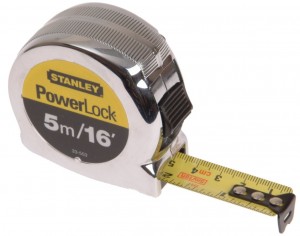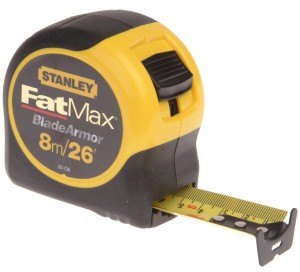Tape measures
The best tape measures on the market are manufactured by Stanley, but as is the case with most DIY tools, there is an enormous range to choose from, and so deciding what is the best option can be tricky. Therefore, below I’ve outlined the key features to look for when buying a tape measure, and why this is a case where I always find that two is better than one.
Tape measure length

Stanley, 5m Powerlock tape measures are simply reliable, accurate, and hardwearing. More details further down the page……
Tape measures tend be sold in standard lengths of 3,5,8, and 10 metres. For me, this actually means 2, 4, 7 and 9 metres as when you start extending any tape measure to its full length, with any sort of regularity, it soon puts too much strain on the spring/coil of the retraction mechanism and basically, it breaks. Therefore, always work well within the limits of the tape measure to guarantee long life.
For me, 10m tapes are just too long – it is very rare for a DIY job to need this sort of length, and if your rooms are of these proportions, I would suggest you’ll be paying someone to do the job, rather than doing it yourself. At the other end of the scale, 3m tapes are just too short, and often very flimsy, so I tend to go for the 5m and 8m options.
Retractibility
All these tape measures retract when you hit a button on the tape body – some fire back at the “speed of light”, some have brakes, or differing controls, or are dual speed, or are etc etc etc. To be honest, all you need is the tape to lock when its extended, and for it not to take your hand off when it retracts. Extra buttons etc etc, are all something else to go wrong. Therefore I’d always choose a tape measure with one button that does the lock and release.
Tape measure hook
The tape measure hook is the metal “right-angled” section at the beginning of the tape that you “hook” over something to hold the start of the tape measure in position as you extend it. Many people think that the fact that the hook moves, means the tape measure is either broken or of poor quality. Well, this is not the case as the hook MUST move in order for you to take accurate measurements, for the two most common measuring situations. For the first situation, where you hook the beginning of the tape on a corner, say a door edge, the movement of the hook makes an allowance to effectively positions point ‘0’ of the tape on the precise edge of the door – therefore you can make an accurate measurement. For the second situation, such as measuring inside a recess, the hook gets pushed tighter up to the tape and effectively makes an alllowance for the width of the hook (normally 1mm) in your measurement. Without this clever movement, in either situation, all your measurements would be 1-2mm ‘out’. Therefore hooks need to move, and the best quality tapes tend to have three, rather than two, rivets holding them in place.
Two is better than one
Yes, you can buy one tape measure that will cope with the vast majority of your needs, but I always have two available, for two reasons. Firstly, of all the tools that you leave lying around and “lose”, tape measures are the top of the list. Nothing is more infuriating than spending hours looking for a tape measure, so if you have two, you spend five minutes looking, and then go and get your spare one. Within one minute of using your spare tape measure, 90% of the time, the other one then turns up – don’t ask me why? – it just happens. But rather than buy the exact same models/sizes, use the opportunity to help deal with any measuring situation you may have….
Final choices

The Stanley Fatmax 8m is my favoured ‘bigger’ tape measure. Strong, and accurate, and your ideal ‘spare’.
Therefore I always have available a 5m tape measure and an 8m tape measure. 5m is just the perfect length. It deals with most room widths, depths and heights, and if you pick the right model, fits in your pocket easily. My spare tape measure is the 8m option, as this comes out on the occasions I “lose” my 5m tape, or need a very long measurement – down a hallway for example. 8m tapes are bulkier, and you can’t normally pop them in your pocket, and however much I try to clip them on my belt, jeans, pocket etc., it’s sad, but I’ve never managed to master the technique of doing “it” without wasting half the day. Therefore I just keep it in reserve for use as, and when, required.
My choices come from the Stanley range, because of the undeniable quality and strength of metal used, as well as the all-important accuracy. Both the highlighted links will take you to Amazon, although you can find them stocked with many other online suppliers. My pocket tape measure of choice is the Stanley 5m/16′ Powerlock Tape(pictured at the top), and my bigger option, or spare tape measure is the Stanley Fatmax Tape 8M/26FT 0-33-726 (pictured above). The Fatmax is, in my view expensive, but it is top of the range for me, and has one or two extra features in terms of strength and rigidity, which I think, more than compensate for the price.
